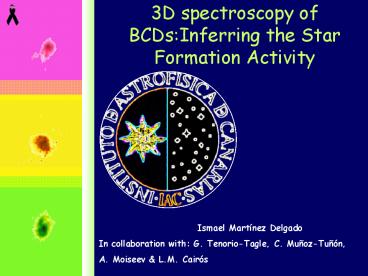PowerPoint PPT Presentation
1 / 18
Title:
1
3D spectroscopy of BCDsInferring the Star
Formation Activity
Ismael Martínez Delgado In collaboration with
G. Tenorio-Tagle, C. Muñoz-Tuñón, A. Moiseev
L.M. Cairós
2
3D Spectroscoy The SIL Diagrams
Granada, 2 March 2007
3
Observations
4
(No Transcript)
5
3D Spectroscoy The SIL Diagrams
Metodology
Single gaussian fit profile to the emission lines.
Ipeak (a.u.) s (km s-1) ?c (Å)
Mrk 600
Granada, 2 March 2007
6
3D Spectroscoy The SIL Diagrams
NGC604
Muñoz-Tunón et al 1996
Granada, 2 March 2007
7
3D Spectroscoy The SIL Diagrams
NGC604
Muñoz-Tunón et al 1996
Granada, 2 March 2007
8
(No Transcript)
9
I. Martínez-Delgado, submitted to AJ (105-106 M ?)
10
(No Transcript)
11
(No Transcript)
12
(No Transcript)
13
I. Martínez-Delgado, submitted to AJ (105-106 M ?)
14
(No Transcript)
15
(No Transcript)
16
(No Transcript)
17
Galaxy - Galaxy Collision
- Alloin Duflot (1979) is a colliding system
between two disk galaxies, one in the NW and the
other in the SE
- Taniguchi et al (1991) A co-planar radial
penetration collision between two disk
galaxies
18
(No Transcript)
19
3D Spectroscoy The SIL Diagrams
Granada, 2 March 2007
20
Summary and conclusions
- THE SIL DIAGRAMS
- The s vs Ipeak is an excellent diagram to
separate the main broadening mechanism affecting
the emission lines that lead to shells, loops by
the violent action of the massive stars. - The s horizontal band, for the case of multiple
massive nuclear burst of SF, has been shown to
split in different bands in the ?c vs Ipeak. - The s vs ?c diagram picks up the small burst of
stellar formation by tracing their lower
intensity and slower expansion of their immediate
surroundings. - In the case of III Zw 102 the stalactites
correspond to the outer ionized regions and their
spred in s is the result of their expansion in a
lower density medium. . - In the case of Mrk 297 the displacement among
the emission lines between two areas of the
galaxy are consistent with previous works for a
collition event. - On the whole, the SIL diagrams, provide the
posibility of inferring the SF activity in
distant galaxies even if these are not spacially
resolved by means of 3D spectroscopy.
21
3D spectroscopy of BCDsInferring the Star
Formation Activity
Ismael Martínez Delgado In collaboration with
G. Tenorio-Tagle, C. Muñoz-Tuñón, A. Moiseev
L.M. Cairós

